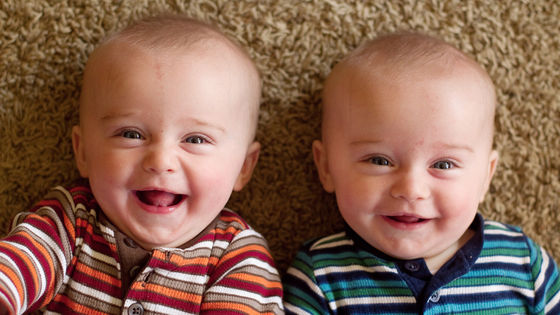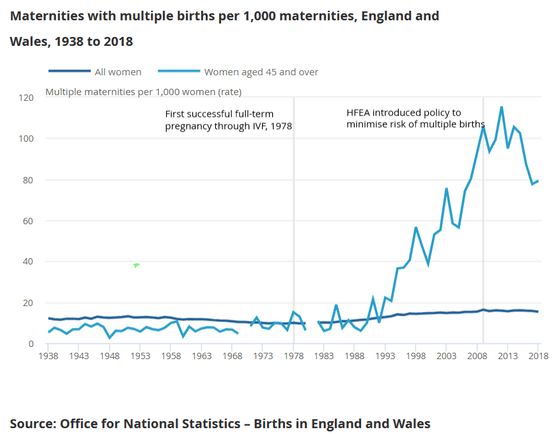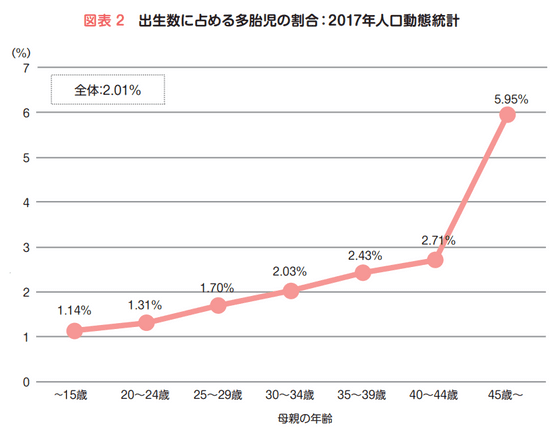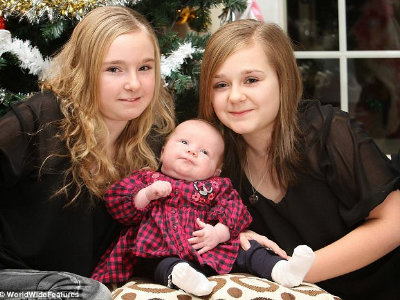Why are twins being born more than ever before, even though birth rates are falling?

The birth rate is declining worldwide, including in Japan, where a declining birthrate and aging population has long been a concern, but the proportion of twins and triplets among newborns is said to be increasing to unprecedented levels. Experts have analyzed this phenomenon, which is expected to continue in the future.
Why more twins are being born than ever before – even though birthrates are falling

According to Elizabeth Bailey, director of the Elizabeth Bryan Multiple Birth Centre at Birmingham City University in the UK, during the baby boom in the UK from the 1940s to the 1960s, 12 to 13 out of every 1,000 pregnancies were 'multiple births' such as twins or triplets.
Then, in the 1970s and 1980s, the number of large families decreased due to the spread of family planning, including sterilization, and the worsening economic situation, with the typical family having around 2.4 children. As a result, the rate of multiple births also decreased to around 10 per 1,000 pregnancies.
However, the rate of multiple births began to increase in the 1990s and 2000s, peaking at 16.4 cases per 1,000 in 2009.

There are many reasons for this trend, but Bailey believes the main drivers are societal factors such as older pregnancy and increased access to fertility treatments.
In the first place, twins occur when a fertilized egg splits into two or when two separate eggs are fertilized at the same time. Therefore, multiple births are more likely when multiple eggs are released during the same cycle, a phenomenon known as 'superovulation.' This phenomenon is more common as women approach menopause and their menstrual hormonal patterns change, meaning they become older.
Although rare, superovulation can result in triplets or more, or even up to nine babies, known as a 'higher order multiple pregnancy.'
Below is a graph showing the rate of multiple births per 1,000 pregnancies in England and Wales for all women (dark blue line) and women over 45 (light blue line). At a glance, we can see that women over 45 are more likely to have multiple births.

This trend is not unique to the UK. For example, the Japanese

Fertility treatments are also a factor, and in early fertility treatments, it was common to implant multiple embryos at once to increase the chances of successful pregnancy. This increased the chances of multiple births, and in the 1990s, the rate of multiple pregnancies due to fertility treatments rose to 28%. In contrast, the rate of multiple pregnancies occurring naturally is only 1-2%.
Concerns over the sharp rise in multiple births resulting from fertility treatments and the resulting increase in premature births have led to the launch of the 'One at a Time' campaign in the UK, which promotes the transfer of only one embryo at a time, aiming to stabilize the rate of multiple births resulting from fertility treatments at 4% by 2022.

The birth of multiple babies is a blessing for many families, but it also brings challenges. In the UK, twin stillbirth rates are almost twice as high as single pregnancies, and the neonatal mortality rate is three times higher. Multiple babies are also more likely to be born prematurely, and generally require more care, placing greater strain on families.
'When planning for future births and early childhood care, the needs of multiple births should be included in discussions. It is difficult to predict how much the rate of multiple births will increase, but it is likely that over time, fewer babies will be born and the rate of multiple births will increase,' she said.
Related Posts:
in Science, Posted by log1l_ks







